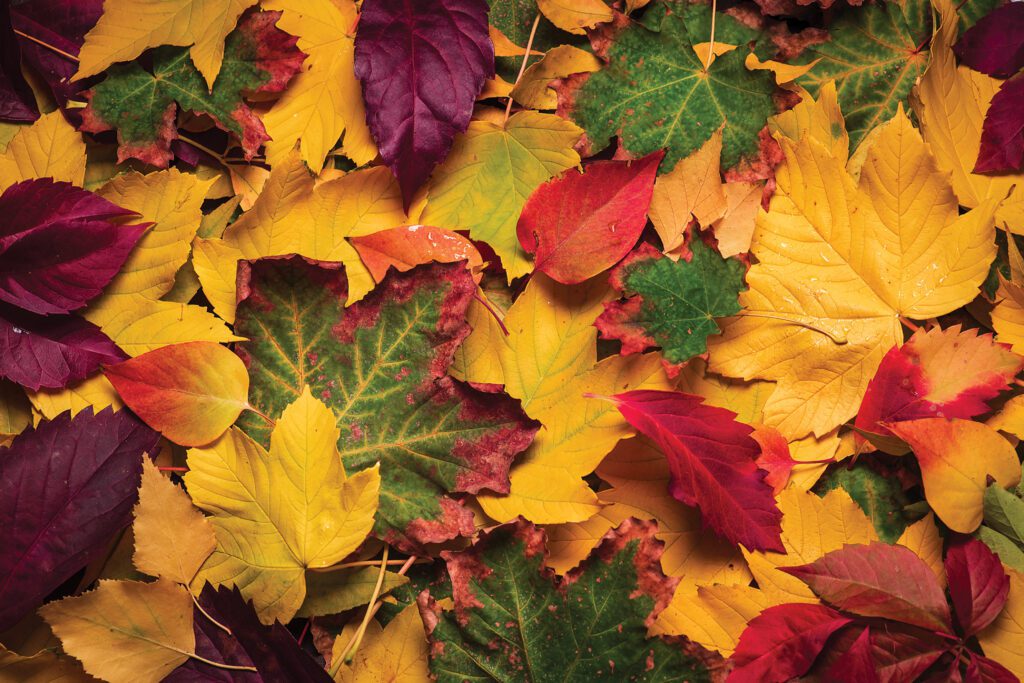A favorite season for many, fall elicits connotations of football fandom, local fairs and festivals, and pumpkin spice everything. Gone are the impossibly hot days of summer, and the crisp air that takes over feels refreshing. Unfortunately, the changing weather patterns create a perfect storm for fall allergy triggers. Dr. Joe Wisniewski, an allergist with Covenant Allergy & Asthma Care, explains, “Fall allergy season in the Chattanooga area usually starts in mid-August, peaks in September, and continues until we have a hard frost.” To avoid the sneezing, runny nose, and other less than desirable symptoms, it’s important to know the most common triggers and the solutions to keep you sniffle-free all season long.
The Primary Culprits
Ragweed
Unlike trees, which pollinate in the spring, and grasses, which pollinate in the summer, weeds are what give us trouble in the fall. Ragweed is the most common fall allergy trigger, and a single ragweed plant can produce up to one billion grains of pollen per season. What’s worse, that pollen can travel hundreds of miles in the wind, meaning that even if you don’t have it in your own backyard, it’s nearly impossible to avoid.
“Ragweed allergies are extremely common in certain parts of the country, and especially here,” says Dr. Lee Perry, an allergist with Chattanooga Allergy Clinic. “There is nowhere for the pollen to go, so it settles in the valley, causing flare-ups for a number of individuals.”


According to the Asthma and Allergy Foundation of America, about 75% of people who suffer from springtime allergies will also be affected by pollen from ragweed. And for some people who are allergic to ragweed, certain foods and drinks like bananas, cantaloupe, chamomile tea, and honey may even cause symptoms. The most common signs of a ragweed allergy include stuffy or runny nose, sneezing, trouble sleeping, and itchy eyes, nose, and throat.
Mold
Mold is another cause for concern in the fall. While pollen tends to be killed by a strong frost, mold can survive both outdoors and indoors year-round. These spores love damp areas indoors like bathrooms, kitchens, and basements, but they also flourish in areas outside.
“Mold thrives in leaf piles in the fall, since the spores are attracted to cool, wet environments. From there, they can get into the air and travel,” says Dr. Russell Walker, an allergist with The Allergy & Asthma Group of Galen. Mold spores can cause symptoms like you see with ragweed, such as sneezing, itching, runny nose, and congestion. If the spores reach the lungs, they can lead to worsening asthma over time.
Dust Mites
“Dust mites are major indoor allergens year-round but tend to be worse in the late summer, fall, and early winter,” says Dr. Wisniewski. “They need moisture to survive, and fall’s temperature and moisture levels provide the optimal environment.” Microscopic arthropods not visible to the naked eye, dust mites prefer warmer environments (around 68 to 77 degrees Fahrenheit) with high levels of humidity. Dr. Walker explains, “They are mainly found in your carpeting and bedding. The body parts and waste they leave behind are what actually trigger allergies.” Some of the most common symptoms are sneezing, coughing, runny nose, and itchy, red, or watery eyes, among others.
Solutions
Avoidance Measures



Mold thrives in leaf piles in the fall, since the spores are attracted to cool, wet environments. From there, they can get into the air and travel."
Dr. Russell Walker
If you’re struggling with fall allergies, avoidance measures are the first cornerstone of treatment. With ragweed, monitor the pollen count for your area and stay indoors when it’s high. Dr. Walker explains, “As far as pollens go, the best time to go outside is early in the morning, when there’s likely dew on the ground. Pollen gets worse mid-day or in the afternoon, once it’s drier outside.”
It’s also wise to vacuum cars and upholstery, and wash clothes and curtains regularly. If you have pets, bathe them frequently, especially if they spend a lot of time outdoors. When you’re spending time outdoors, wear sunglasses and a hat to help keep pollen out of your eyes.
If you have a mold allergy, be sure to wear a mask when doing yardwork like cutting grass, picking up leaves, and planting. Dr. Perry recommends avoiding yardwork entirely immediately after a rain. “Mold spores are stimulated by the wet weather and become more active in the air right after it rains,” he says.
In order to reduce mold spore exposure inside, be sure to use a HEPA filter attachment when using your central air conditioning (this helps to trap the mold spores), lower your indoor humidity to below 45% (using a dehumidifier helps), and in general, pay close attention to rooms in your home that may be susceptible to mold such as a bathroom, kitchen, or basement.
Since dust mites are a year-round issue, it’s best to regularly wash sheets in water that is 130 degrees Fahrenheit or hotter (dust mites cannot survive in extreme temperatures). Once the weather starts cooling down, clean your air vents before turning on heat for the first time to avoid spreading dust mites. In homes with carpet, vacuuming and dusting frequently while wearing a dust mask can help to alleviate allergies.
Over-The-Counter Medications
If avoidance measures aren’t doing the trick, over-the-counter options may relieve those bothersome symptoms. The most effective medication for relieving nasal allergies are nasal corticosteroids, which are great for reducing swelling. “Nasal steroids are more effective than antihistamines at preventing nasal allergies and block both an early and late phase of allergic inflammation,” explains Dr. Wisniewski.
Antihistamines like Claritin and Zyrtec are the most diverse OTC option, as you can get them in the form of liquids, pills, nasal sprays, and more. These treat symptoms, not the underlying problem, and might be appropriate on an as-needed basis for someone with occasional symptoms.
Oral decongestants like Sudafed are another common option for relief. By shrinking the swollen blood vessels and tissues in the nose, decongestants alleviate the swelling in the lining of the nose caused by allergies. Decongestants can cause side effects for some people, like trouble sleeping or jitters, and they’re not intended for everyday use. If you have high blood pressure, glaucoma, heart conditions, diabetes, or thyroid problems, talk to your doctor before taking a decongestant.
Seeing an Allergist
If you are experiencing frequent allergy symptoms with little relief, a trip to the allergist could be your most effective option. Dr. Perry shares, “When someone comes to an allergist, we’ll sit down and discuss what symptoms the patient is facing, what time of year they’re worst, and more. Our goal is to decrease the need for medicine and allow patients to enjoy the outdoors year-round.”
Your allergist may perform a skin test, which involves a series of injections that contain a small dose of several different allergens. Following administration, the allergist can see which allergens cause a skin reaction, and develop a treatment plan tailored to your needs. This can include allergy immunotherapy, commonly known as allergy shots. Allergy immunotherapy is administered every week or two using small doses of the allergen to gradually reduce reactions to the allergens over time.
Taking care of your health is important, even if it is “just” allergies. So, get out and enjoy the fall weather, and don’t let allergies dampen your day.



Dr. Lee Perry
Allergist, Chattanooga Allergy Clinic



Dr. Russell Walker
Allergist, The Allergy & Asthma Group of Galen



Dr. Joe Wisniewski
Allergist, Covenant Allergy & Asthma Care

